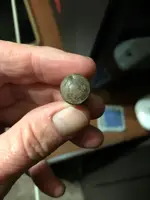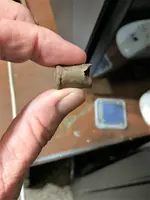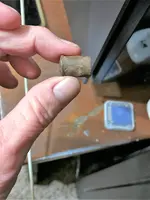Help me date cartridge casing with dual firing pin marks



I am looking for some information about an old shell casing I dug up a couple of days ago. I posted here because the casing looks very similar to the one the fellow posted above in 2007. There was a good discussion about the first casing but no conclusions.
First of all, it was found about six inches down (just at or below the plow line) in a field in what used to be in old Indian Territory (now Oklahoma). It was found very near a house that I have verified was there in 1870. The field where the house was located is very near the Washita River and has been in continuous cultivation since the 1870s. The soil where the casing was found is very compact, almost like clay, and was not particularly wet even after a few days of significant rain.
It's difficult to see in the first photo but the head of the casing is stamped with US inside a circle. The printing is in a serif font like Times New Roman. There appears to be another circle etched around the edge of the casing head but I'm not sure. I am confident this shell was made by the United States Cartridge Company, probably during the dates noted above.
The cartridge head is a bit rounded. I understand the bulge may have been caused by the striking of the firing pins when the bullet was fired. It has two, very clear firing pin indentations that are exactly 180 degrees apart, suggesting the shell was fired from a weapon with dual firing pins.
The casing is brass, of course, but seems to contain a bit of copper as well because it has a greenish tint. Measured with a caliper, it is 9/16" in length (just a hair over a half-inch) and the barrel (I may not be using the right language) is 7/16" wide, which would make it .4375 inches. I understand that the action of firing the bullet caused the barrel to expand somewhat so I measured it just underneath the head. As shown in the second photo, the barrel seems "ripped" or blown out, perhaps suggesting a misfire?
Compared to other ammo I have around, the casing is larger than a .38 round but seems smaller than a .45. I don't have a .44 around to compare.
I took this to a gunsmith who could say only that it was too short to have been fired from a long gun and was not fired by a modern weapon. He speculated that the casing was fired from a derringer-type handgun. I am wondering if the fact that this casing bears dual firing pin marks might help narrow the date a little...
Thanks for any help you can provide.







